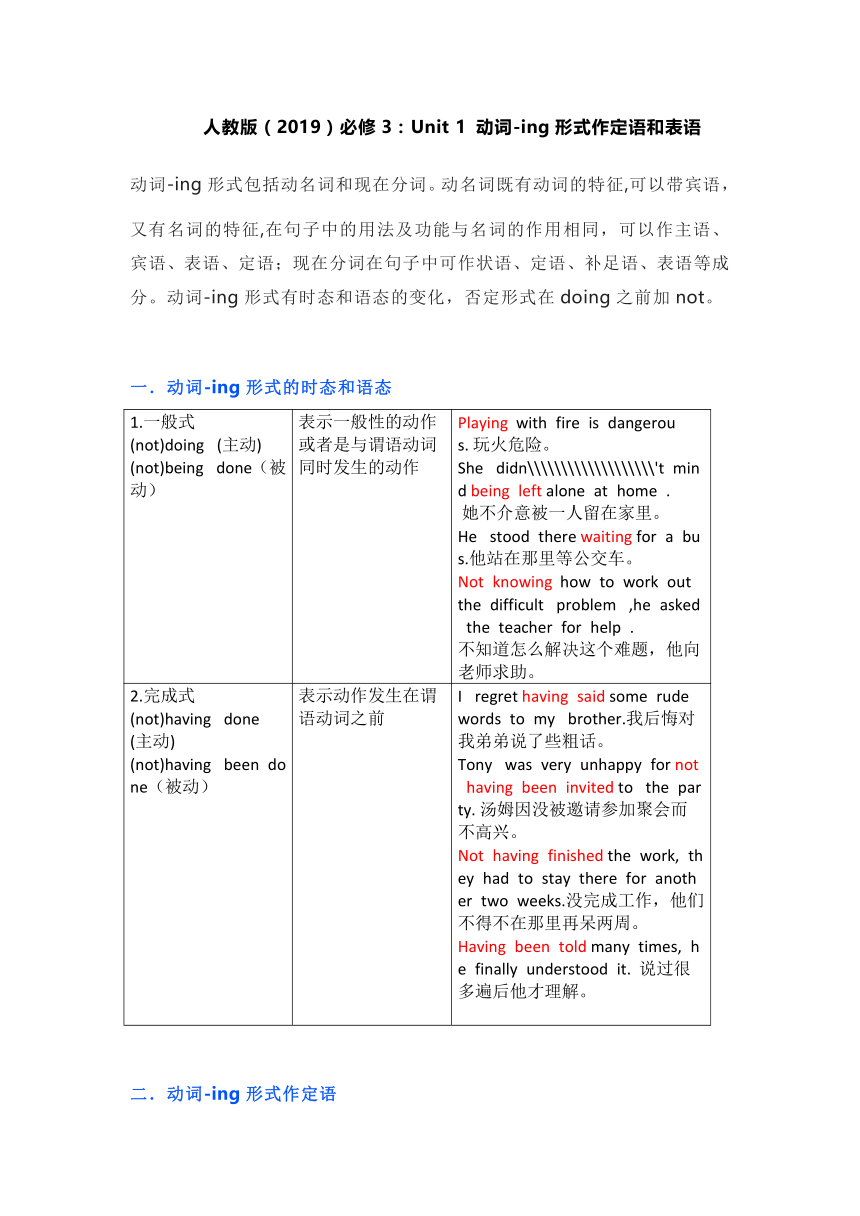
人教版(2019)必修3:Unit 1 动词-ing形式作定语和表语 动词-ing形式包括动名词和现在分词。动名词既有动词的特征,可以带宾语,又有名词的特征,在句子中的用法及功能与名词的作用相同,可以作主语、宾语、表语、定语;现在分词在句子中可作状语、定语、补足语、表语等成分。动词-ing形式有时态和语态的变化,否定形式在doing之前加not。 一.动词-ing形式的时态和语态 1.一般式 (not)doing (主动) (not)being done(被动) 表示一般性的动作或者是与谓语动词同时发生的动作 Playing with fire is dangerous. 玩火危险。 She didn\\\\\\\\\\\\\\\\\\\'t mind being left alone at home . 她不介意被一人留在家里。 He stood there waiting for a bus.他站在那里等公交车。 Not knowing how to work out the difficult problem ,he asked the teacher for help . 不知道怎么解决这个难题,他向老师求助。 2.完成式 (not)having done (主动) (not)having been done(被动) 表示动作发生在谓语动词之前 I regret having said some rude words to my brother.我后悔对我弟弟说了些粗话。 Tony was very unhappy for not having been invited to the party. 汤姆因没被邀请参加聚会而不高兴。 Not having finished the work, they had to stay there for another two weeks.没完成工作,他们不得不在那里再呆两周。 Having been told many times, he finally understood it. 说过很多遍后他才理解。 二.动词-ing形式作定语 (一)位置 1. 如果是单个的动词-ing形式作定语, 常放在被修饰词前作前置定语。 There is a swimming pool behind the beautiful garden. 在这个美丽的花园后面有一个游泳池。 He asked me an embarrassing question. 他问了我一个令人尴尬的问题。 Make less noise. There’s a sleeping child. 不要发出太大声音, 有个正在睡觉的孩子。 2. 如果是动词-ing形式短语作定语, 则放在被修饰词后作后置定语,相当于一个定语从句。 The man standing there is Peter’s father. = The man who is standing there is Peter’s father. 站在那里的人是皮特的父亲。 3. 动词-ing形式短语也可以用作非限制定语, 放在被修饰词后,用逗号分开,相当于一个非限制性定语从句。 His brother, working as a teacher, lives in Beijing. =His brother, who is working as a teacher, lives in Beijing. 他的哥哥,是个老师,住在北京。 (二)用法 1. 动名词作定语表“用�———�。 a swimming pool =a pool for swimming 游泳池 a sleeping car =a car for sleeping卧铺 a walking stick =a stick for walking 手杖 a waiting room =a room for waiting 候车室 reading materials =materials for reading 阅读材料 2. 表“情感类”的分词作定语,已具有形容词词性: doing(令人……的) done(人感到……的) It was a tiring day. It made me tired. 真是累人的一天。它使我感到很累。 The explanation was confusing. I got confused. 这个讲解是令人费解的,我被弄糊涂了。 3. 现在分词作定语: 1.doing(主动进行) 2.being done(被动进行) 3. having done(主动完成) 4.having been done(被动完成) (注意:having done和 having been done一般不用做定语,但可作非限制性后置定语,并且多和完成时态的时间状语连用。) Do you know the man talking to Tom 你认识正在和汤姆谈话的那个人吗?(=who is talking to Tom) The houses being built now are for the teachers. 正在被建的那些房子是为老师们建的。(=which are being built now) Tom, having worked hard for years ,finally succeeded.汤姆多年努力 ... ...
~~ 您好,已阅读到文档的结尾了 ~~